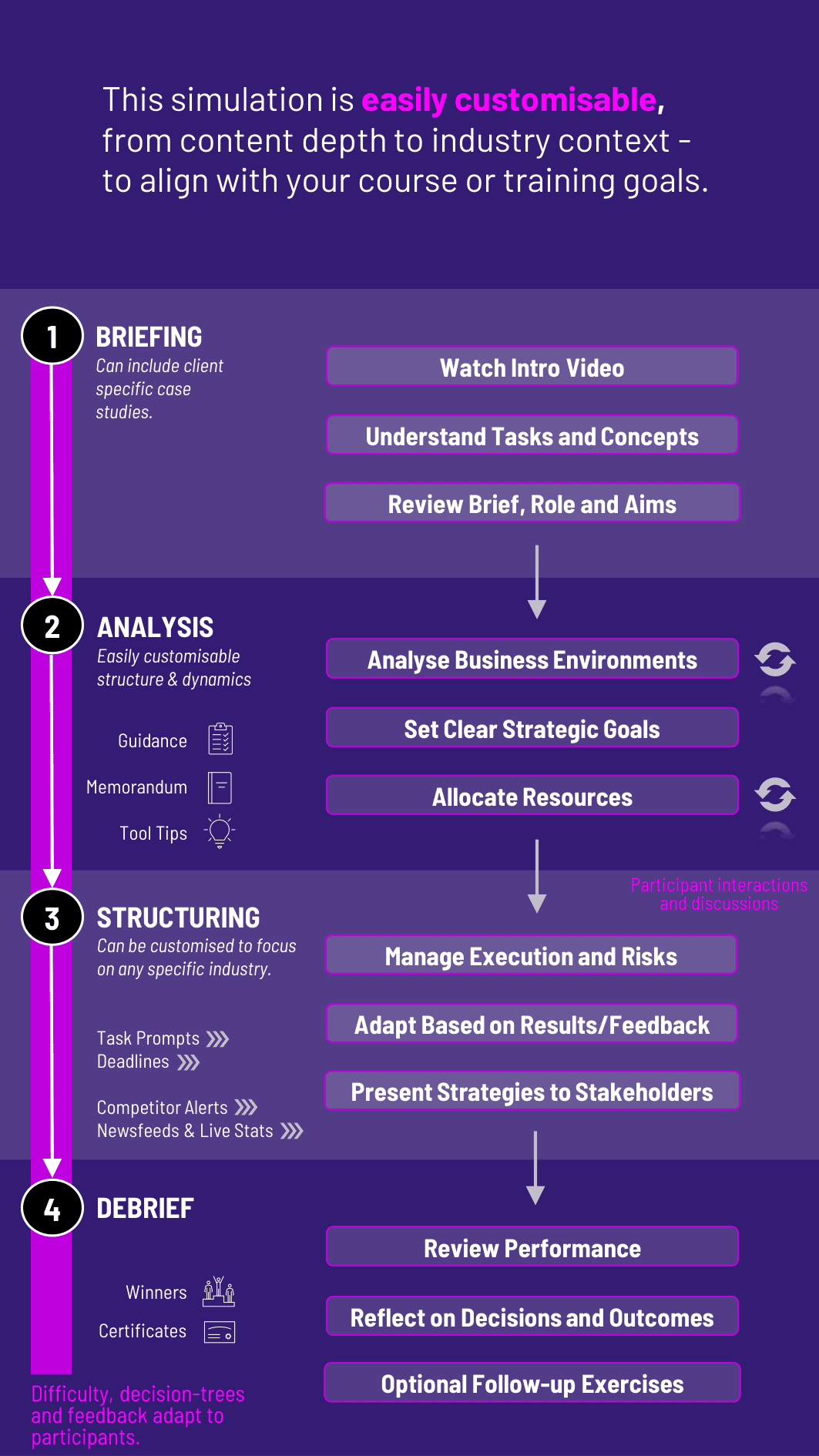
Participants act as strategy leaders navigating real-world trade-offs between growth, risk, competition, and internal capabilities. They design, communicate, and iterate on business plans across dynamic, multi-round scenarios.
SWOT and Competitive Analysis
Strategic Goal-Setting and KPIs
Business Model Design and Trade-offs
Market Segmentation and Targeting
Resource Allocation and Prioritization
Scenario Planning and Risk Mitigation
Internal Alignment (teams, culture, leadership)
External Forces (tech shifts, regulation, competition)
Strategic Communication and Stakeholder Buy-In
Agility and Strategic Iteration


Analyze a company’s internal and external environment
Set clear strategic goals based on data and context
Choose among competing investments or growth initiatives
Allocate limited resources (capital, time, talent)
Manage execution risks and unintended consequences
Respond to shifts in the market and customer demand
Present and defend their strategy to key stakeholders
Adapt their plan based on results, feedback, and new constraints
Build alignment across departments or business units
Reflect on how strategy evolves over time in real business settings
By the end of the simulation, participants will:
Understand how strategic plans are built from internal and external analysis
Set SMART objectives and align actions to them
Make resource allocation decisions under constraints
Conduct scenario planning and evaluate risks
Develop strategic agility and decision iteration
Coordinate across functions and align teams
Forecast business impact with logic and discipline
Use storytelling to gain stakeholder buy-in
Respond to external pressure with clarity and confidence
Reflect on the iterative nature of strategy execution
The course’s flexible structure ensures that these objectives can be calibrated to match the depth, duration, and focus areas of each program.
1. Receive Market Context and Company Brief Each round begins with an overview of the company’s financial health, market position, and upcoming challenges. Participants are tasked with aligning business goals to the situation at hand.
2. Analyze Strengths, Weaknesses, Opportunities, and Threats Participants explore internal data (culture, financials, capabilities) and external forces (competition, macro trends) to decide where to focus.
3. Set Strategy and Make Decisions They create strategic priorities and decide how to allocate resources—across product lines, geographies, R&D, marketing, hiring, and more.
4. Review Feedback and Outcomes Based on their decisions, the course generates performance metrics, market reactions, and stakeholder sentiment.
5. Justify and Communicate Plans Participants are required to explain their logic and defend choices to a virtual board, senior executives, or investors.
6. Adapt Strategy in New Rounds As new disruptions arise, participants must revisit and revise their plans to keep the business on track.
Is this suitable for MBA or undergrad students? Yes, it works at both levels. The course complexity can be adjusted for different learner groups.
Can the course be used in corporate settings? Absolutely. It’s ideal for leadership development, internal strategy teams, or functional heads.
Do participants need prior strategy experience? No. The course is guided and introduces strategic concepts along the way.
Can I customize the industry context? Yes. The base scenarios can be adapted for tech, manufacturing, retail, healthcare, and more.
How long does it take to run? It can be run in a 2 - 4 hour session, a multi-day program, or a full-course format.
Can teams be assigned roles (e.g. CMO, COO)? Yes. Teams can take on executive roles or work together as a strategy unit.
Does it include financial forecasting? Yes. Participants build rough forecasts and track impact of decisions across key metrics.
What formats are available? The course works in person, virtually, or hybrid - with options for both individual and group play.
Is soft skill development included? Yes. Communication, leadership, stakeholder management, and teamwork are all core to the experience.
How is success measured? Based on performance against goals, quality of justification, responsiveness to change, and strategic coherence.
Strategic clarity and prioritization
Resource allocation logic
Responsiveness to changing business context
Communication effectiveness and stakeholder persuasion
Quality of performance outcomes (growth, ROI, risk balance)
Consistency and adaptability across course rounds
Team collaboration (for group courses)
Final strategic presentation or executive memo
Reflection on process and learning
Ability to think long-term while delivering short-term results
Additionally, you can also add a built-in peer and self-assessment tool to see how participants rate themselves. This flexibility allows the simulation to be easily integrated by professors as graded courses at universities.
Join this 20-minute webinar, followed by a Q&A session, to immerse yourself in the course.
or
Book a 15-minute Zoom demo with one of our experts to explore how the course can benefit you.